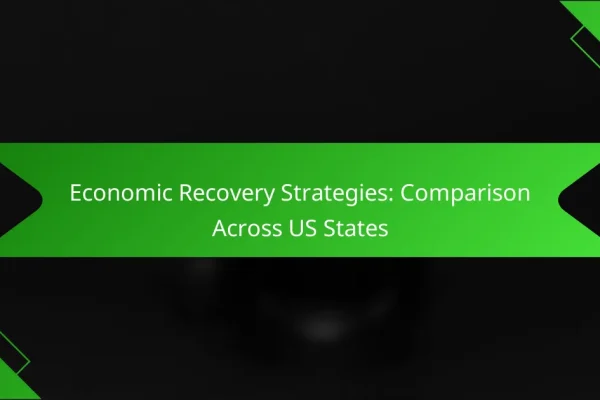How do US trade policies impact the economy?
US trade policies significantly influence the economy by affecting import and export dynamics, which in turn shape domestic production and consumer behavior. These policies, including tariffs and trade agreements, can alter competitive landscapes and economic growth trajectories.
Increased tariffs on imports
Increased tariffs on imports raise the cost of foreign goods, making them less competitive compared to domestic products. This can lead to higher prices for consumers and may encourage local businesses to increase production to fill the gap left by reduced imports.
For example, if tariffs are imposed on steel imports, domestic steel manufacturers may benefit from reduced competition, potentially leading to job growth in that sector. However, industries reliant on imported steel may face higher costs, which could impact their profitability and pricing strategies.
Effects on domestic manufacturing
Higher tariffs can bolster domestic manufacturing by reducing competition from foreign companies. This can lead to increased investment in local factories and job creation, as businesses seek to capitalize on the reduced availability of imported goods.
However, the benefits may vary across industries. While some sectors may thrive, others that depend on imported materials could struggle with increased costs, leading to potential layoffs or reduced output. It’s crucial for policymakers to balance these effects to support overall economic health.
Impact on consumer prices
Trade policies, particularly tariffs, often result in higher consumer prices as businesses pass on increased costs to buyers. This can lead to inflationary pressures, affecting household budgets and spending power.
For instance, if tariffs are applied to electronics, consumers might see price hikes on items like televisions and smartphones. Over time, sustained increases in consumer prices can erode purchasing power and shift spending habits, impacting overall economic growth.
What are the economic effects of inflation in the US?
The economic effects of inflation in the US primarily include decreased purchasing power, increased cost of living, and significant impacts on savings and investments. As prices rise, consumers find that their money buys less, which can lead to broader economic challenges.
Decreased purchasing power
Decreased purchasing power occurs when inflation outpaces wage growth, meaning consumers can afford fewer goods and services with the same amount of money. For instance, if inflation is at 5% but wages only increase by 2%, individuals effectively lose purchasing power.
This erosion of value can lead to changes in consumer behavior, such as prioritizing essential items over luxury goods. As a result, businesses may experience shifts in demand, impacting their revenue and growth prospects.
Increased cost of living
Inflation contributes to an increased cost of living, affecting housing, food, transportation, and healthcare expenses. For example, rising prices for groceries and rent can strain household budgets, forcing families to cut back on discretionary spending.
In urban areas, the cost of living can escalate quickly, leading to affordability issues. Individuals may need to consider relocating to areas with lower living costs or seek additional income sources to maintain their standard of living.
Impact on savings and investments
Inflation can diminish the real value of savings, as the interest earned on savings accounts often fails to keep pace with rising prices. For instance, if a savings account offers a 1% interest rate while inflation is at 3%, the purchasing power of those savings decreases over time.
Investors may also adjust their strategies in response to inflation. Assets like stocks and real estate often serve as hedges against inflation, while fixed-income investments may lose value. Diversifying investment portfolios can help mitigate risks associated with inflationary pressures.
How does unemployment affect economic growth?
Unemployment negatively impacts economic growth by reducing the overall productivity and spending power of the workforce. When individuals are without jobs, their ability to consume goods and services diminishes, leading to a slowdown in economic activity.
Reduced consumer spending
High unemployment rates lead to reduced consumer spending, as unemployed individuals have less disposable income. This decline in spending affects businesses, resulting in lower revenues and potential layoffs, creating a vicious cycle that further exacerbates unemployment.
For example, during periods of high unemployment, retail sales often drop significantly, impacting sectors such as hospitality and entertainment. Businesses may respond by cutting prices or reducing their workforce, which can prolong economic downturns.
Increased government spending on welfare
As unemployment rises, government spending on welfare programs typically increases to support those without jobs. This spending includes unemployment benefits, food assistance, and housing subsidies, which can strain public finances.
In the United States, for instance, the federal and state governments may need to allocate billions of dollars to support unemployed individuals, diverting funds from other essential services like education and infrastructure. This shift can hinder long-term economic growth.
Long-term productivity loss
Extended periods of unemployment can lead to long-term productivity loss as skills become outdated and workers lose their professional networks. This phenomenon, often referred to as “skills erosion,” can make it difficult for individuals to re-enter the workforce effectively.
Moreover, businesses may face challenges in finding qualified candidates to fill positions, leading to inefficiencies and lower overall productivity in the economy. Addressing this issue requires targeted training programs and initiatives to help unemployed individuals regain their skills and re-enter the job market.
What role do interest rates play in the economy?
Interest rates are a crucial factor in the economy as they influence borrowing, spending, and saving behaviors. When rates rise, borrowing costs increase, which can slow economic growth, while lower rates typically encourage spending and investment.
Influence on borrowing costs
Interest rates directly affect borrowing costs for consumers and businesses. Higher rates mean that loans become more expensive, which can deter individuals from taking out mortgages or personal loans and businesses from financing expansion. Conversely, lower rates reduce these costs, making loans more accessible.
For example, a 1% increase in interest rates can significantly raise monthly payments on a mortgage, potentially affecting home affordability for many buyers. Understanding these dynamics is essential for making informed financial decisions.
Impact on housing market
The housing market is particularly sensitive to changes in interest rates. When rates are low, more buyers can afford homes, leading to increased demand and potentially driving up prices. Conversely, if rates rise, fewer people can qualify for loans, which can lead to a slowdown in home sales and price corrections.
For instance, a rise in rates from 3% to 5% can reduce the purchasing power of buyers, making it harder for them to afford homes in competitive markets. This shift can lead to a cooling effect on housing prices and a slowdown in new construction projects.
Effects on business investments
Interest rates significantly influence business investment decisions. When rates are low, companies are more likely to borrow money to invest in new projects, equipment, or expansion. Higher rates, however, can lead to increased costs of financing, causing businesses to delay or scale back investments.
For example, a small business considering a loan for new equipment may find that a 2% interest rate is manageable, while a jump to 5% could make the investment less appealing. Businesses must carefully assess the cost of capital when planning their growth strategies in response to interest rate fluctuations.
How do fiscal policies shape economic stability?
Fiscal policies significantly influence economic stability by determining government spending and taxation levels. These policies can stimulate growth during downturns or help cool an overheating economy, impacting employment rates and inflation.
Government spending initiatives
Government spending initiatives play a crucial role in driving economic activity. By investing in infrastructure, education, and healthcare, the government can create jobs and enhance productivity. For example, a large-scale infrastructure project can lead to immediate job creation while improving long-term economic efficiency.
However, it’s essential to balance spending with revenue to avoid excessive debt. Initiatives should be targeted to areas that yield the highest economic returns, ensuring that funds are used effectively.
Taxation changes
Changes in taxation can directly affect disposable income and consumer spending. Lowering taxes can increase household spending power, stimulating demand for goods and services. Conversely, raising taxes may be necessary to fund essential services but can reduce consumer spending and slow economic growth.
Policymakers must consider the trade-offs of tax changes, as they can impact different income groups differently. For instance, tax cuts for lower-income households typically lead to higher spending compared to cuts for higher-income individuals, who may save a larger portion of their income.
Debt management strategies
Effective debt management strategies are vital for maintaining economic stability. Governments must manage their debt levels to ensure they remain sustainable, avoiding scenarios where debt servicing becomes a burden on future budgets. This can involve refinancing existing debt or implementing fiscal measures to reduce deficits.
Investors often look at debt-to-GDP ratios as a key indicator of economic health. A stable or declining ratio can instill confidence, while rising levels may raise concerns about a government’s ability to meet its obligations. Regular assessments and adjustments to fiscal policies can help maintain a favorable debt profile.
What are the economic implications of healthcare reform?
Healthcare reform in the US can significantly impact the economy by altering costs, access, and quality of care. Changes in healthcare policies can lead to shifts in spending patterns, workforce productivity, and overall public health outcomes.
Cost of Healthcare
The cost of healthcare is a critical factor in economic implications. Reforms may aim to reduce out-of-pocket expenses for individuals and families, potentially lowering the financial burden on households. However, these changes can also lead to increased taxes or premiums to fund expanded coverage.
For example, the introduction of universal coverage could initially raise government spending but might lead to long-term savings through preventive care and reduced emergency services. It’s essential to analyze both short-term and long-term financial impacts when considering reforms.
Access to Care
Access to healthcare services can improve significantly with reform, allowing more individuals to receive necessary medical attention. Increased access often leads to better health outcomes, which can enhance workforce productivity and reduce absenteeism.
However, reforms that expand access may strain existing healthcare resources, potentially leading to longer wait times and reduced quality of care in the short term. Balancing access with quality is crucial for sustainable healthcare reform.
Impact on Employment
Healthcare reform can influence employment rates and job creation. Expanding coverage may encourage businesses to hire more employees, knowing that healthcare costs are managed more effectively. Conversely, increased regulations could lead to higher operational costs for some businesses.
For instance, small businesses might struggle with new mandates requiring them to provide health insurance, which could deter hiring. Policymakers must consider the balance between ensuring coverage and supporting job growth.
Public Health Outcomes
Improved public health outcomes are often a goal of healthcare reform, leading to a healthier population that can contribute more effectively to the economy. Better health can reduce the incidence of chronic diseases, lowering healthcare costs in the long run.
However, achieving these outcomes requires careful planning and investment in preventive care and health education. Without adequate resources, the anticipated benefits may not materialize, leading to continued economic strain.











